
|
INTER
|

|
SECTION
|
Inter~Section Melbourne
(Contact Mannie De Saxe and Kendall Lovett 03 9471 4878)
PART 4
Contact us at: josken_at_josken_net
Indexed by the FreeFind
Search Engine

Darebin Council and Sexual Minority Issues in Local Government
Inter~Section Melbourne intends carrying on the policy change programmes in Victoria that it began in New South Wales in 1996-1997 with local governments being made aware of sexual minority issues in their communities.
Inter~Section's actions resulted in the inclusion in the May 1998 publication of the New South Wales Department of Local Government document: "Social/Community Planning and Reporting MANUAL" of "seven mandatory target groups, and the non-mandatory groups mentioned in the paragraph below these seven:
* Children
* Young people
* Women
* Older people
* People with disabilities, including those with HIV/AIDS
* Aboriginal people
* People from culturally and linguistically diverse backgrounds
Councils may also include information about other specific groups in their community such as low income earners, gay/lesbian and transgender people, families, new residents and unemployed people."
The manual's "Specific target groups" section goes on to say:
"Councils also need to consider specific legal requirements that will affect their planning for particular groups in the community. Part D of the Department's Social and Community Planning and Reporting Guidelines contains details of councils' obligations under the Local Government Act, the Ethnic Affairs Commission Act and the Disability Discrimination legislation.
Councils should also note the existence of state and commonwealth anti-discrimination legislation covering councils outlined in Part D of the Department's Social and Community Planning and Reporting Guidelines. Athough gays and lesbians are not one of the seven mandatory target groups, Councils should make sure that their planning takes their needs into account and council does not inadvertently discriminate against these groups. Appendix A contains more information about planning to assist sexual minority citizens."
Appendix A is reproduced in full below:
Planning to Assist Sexual Minority Citizens
This information will help councils to make sure that their planning takes into account the needs of sexual minority citizens living within their community and they comply with State and Commonwealth anti-discrimination legislation.
Councils should be aware of privacy concerns when conducting a needs analysis for this target group. Many people within this group face direct or indirect discrimination as a result of their sexual preference so councils need to be sensitive to these issues when assessing their needs.
When formulating and reviewing their planning processes, Councils should:
A. Identify the degree to which gays, lesbians, bisexuals and transgender people are isolated.
* Do Council funded or operated community information services include information on services and issues appropriate to their needs?
* Are any Council facilities targeted for these groups to use for meetings, cultural events etc.?
* Has Council provided or funded any cultural activities, events or festivals for this population group?
* Are the problems of harassment and violence included in any Council reports, activities or committee/forum discussions on local safety needs?
* Do Council libraries include a range of written, audio andvisual resources appropriate to their needs?
* Are Council consultations on community needs and issues involving, and providing information on, this target group?
B. Identify the barriers experienced by gays, lesbians, bisexuals and transgender people in accessing council facilities, services and processes.
* Has there been any advocacy by local community service providers, school counsellors, police and health service providers of the needs of this population group?
* Are council services personnel and consulting service providers saying there are no gays, lesbians or transgender people using their services or that there are so few as not to require needs identification? If so, what are the rationales used to support these beliefs?
* Are Council staff sensitive to the needs of this population and have they received any training in working with, or being aware of, their needs?
* Are staff including references to these needs and issues in their work and developing resources which can also be used by gays, lesbians and transgender people?
* Do Council policies provide for equality of access for these citizens?
* Is there a staff development plan to look at access and equity activities, including training, to overcome the barriers experienced by this population group?


